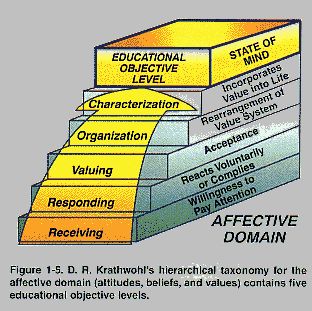Bloom's Taxonomy Affective Domain
The purpose was to equip educators with common. Revisions to the taxonomy structure have been made since Blooms original work and currently each level of learning in each domain contains.

Instructional Design Learning Theories Krathwohl S Affective Domain Taxonomy Cplp Learning Theory Instructional Design Teaching Strategies
Taxonomy of educational objectives are composed of three parts Taxonomy of Cognitive domain Affective domain and Psychomotor domain.

. Blooms Taxonomy Affective Domain - Simplest explanation everRenowned taxonomy in the world of business and LDBlooms Taxonomy is a renowned model for ga. Cognitive Affective and SensoryPsychomotor. A committee of colleges led by Benjamin Bloom identified three domains of educational activities.
The affective domain is one of three domains in Blooms Taxonomy with the other two being the cognitive and psychomotor Bloom et al 1956. The affective domain is one of three domains in Blooms Taxonomy with the other two being the cognitive and psychomotor Bloom et al 1956. Cognitive affective and psychomotor.
The Three Types of Learning. What is Blooms Taxonomy. Affective outcomes tend to be the hardest to articulate initially and often appear difficult to assess at first glance.
Blooms Taxonomy comprises three learning domains. Each domain on this page has a taxonomy associated with it. The affective domain Krathwohl Bloom Masia 1973 includes the manner in which we deal with things emotionally such as feelings values.
Benjamin Bloom an American educational psychologist proposed the taxonomy in the 1940s. The affective domain is one of three domains in Blooms Taxonomy with the other two being the cognitive and psychomotor Bloom et al 1956. Instructional objectives are concerned with the students general patterns of adjustment personal social emotional.
However cognitive outcomes often represent the outcomes most closely. There is more than one type of learning. For an overview of the three domains see the introduction.
Affective domain Krathwhol Bloom and Masia 1964 defining behaviors that correspond to attitudes and values. These three domains of learning are- cognitive affective and psychomotor. The affective domain Krathwohl Bloom Masia 1973 includes the manner in which we deal with things emotionally such as feelings values.
The taxonomy was proposed by Benjamin. Shows self-reliance when working independently. However only taxonomy of cognitive.
Blooms Taxonomy Verb List AFFECTIVE DOMAIN Receiving Responding Valuing Organization Internalizing ask accept responsibility associate with adhere to act choose answer assume responsibility alter change behavior follow assist believe in arrange develop code of behavior give comply be convinced classify develop philosophy. Cooperates in group activities displays teamwork. The models organize learning objectives into three different domains.
Krathwohl Bloom Masia 1965. The three domains are cognitive affective and psychomotor. Three domains of learning.
The five major categories are listed from the simplest behavior to the most complex. Domain is the most well-known of the three domains the affective and psychomotor domains also contain important learning behaviors identified by Bloom Bloom 1956. For an overview of the three domains see the introduction.
Blooms taxonomy is a set of three hierarchical models used to classify educational learning objectives into levels of complexity and specificity. The affective domain Krathwohl Bloom Masia 1973 includes the manner in which we deal with things emotionally such as feelings values. Blooms Revised TaxonomyAffective Domain The affective domain Krathwohl Bloom Masia 1973 includes the manner in which we deal with things emotionally such as feelings values appreciation enthusiasms motivations and attitudes.
For an overview of the three domains see the introduction. There are three main domains of learning and all teachers should know about them and use them to construct lessons. Since then the Blooms taxonomy has become the cornerstone of curriculum design across the world particularly in the context of outcome-based education.
These domains are cognitive thinking affective emotionfeeling and psychomotor physicalkinesthetic. Part two explores the affective domain while part three which will appear in the next issue of this. Within each domain learning can take place at a number of levels ranging from simple to complex.
Blooms taxonomy is a set of three models used to classify learning objectives in various domains of learning. Up to 24 cash back The behavior is pervasive consistent predictable and most importantly characteristic of the learner. After the initial cognitive domain was created which is primarily used in the classroom setting psychologists have devised additional taxonomies to explain.
Please refer to the affective table. The Affective Domain Part Two In part one Blooms Taxonomy Its Recent Revision we looked at the history of Blooms Taxonomy its purpose and the way that Bloom and his team categorized learning objectives in the cognitive domain. Since the work was produced by higher education the words tend to be a little bigger than we are normally used to.

Bloom S Affective Domain Blooms Taxonomy Taxonomy Instructional Methods

Affective Domain Of Blooms Taxonomy Taxonomy Blooms Taxonomy Problem Based Learning

Bloom S Taxonomy Affective Ivan Teh Runningman Blooms Taxonomy Effective Teaching Learning Strategies

Bloom S Affective Domain Taxonomy Higher Order Thinking Skills Education

What Is Bloom S Affective Domain Piqc Lec 20 Of 125 By Dr Kamran Moosa Learning Theory Education Taxonomy

0 Response to "Bloom's Taxonomy Affective Domain"
Post a Comment